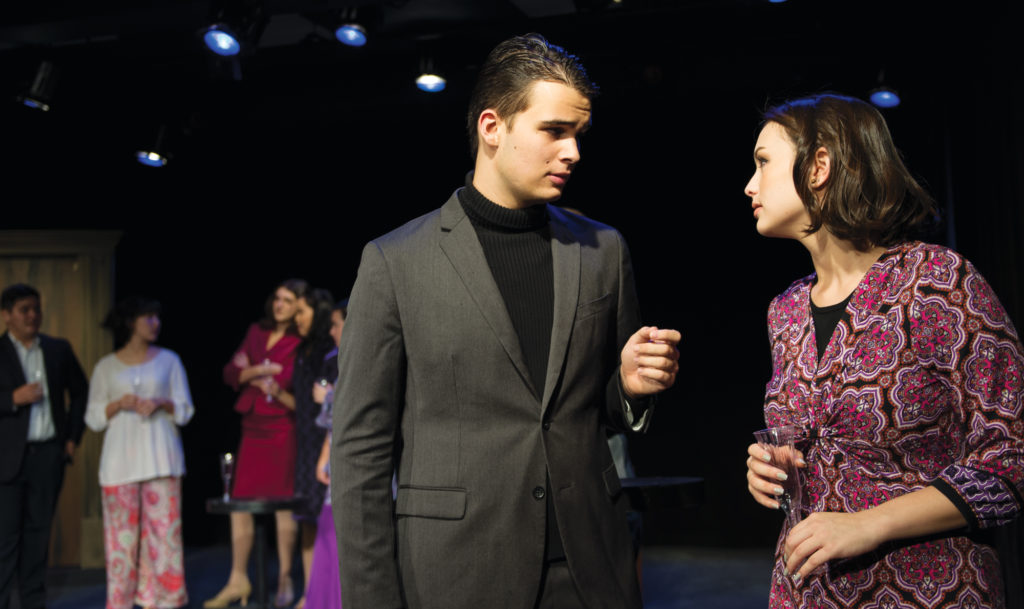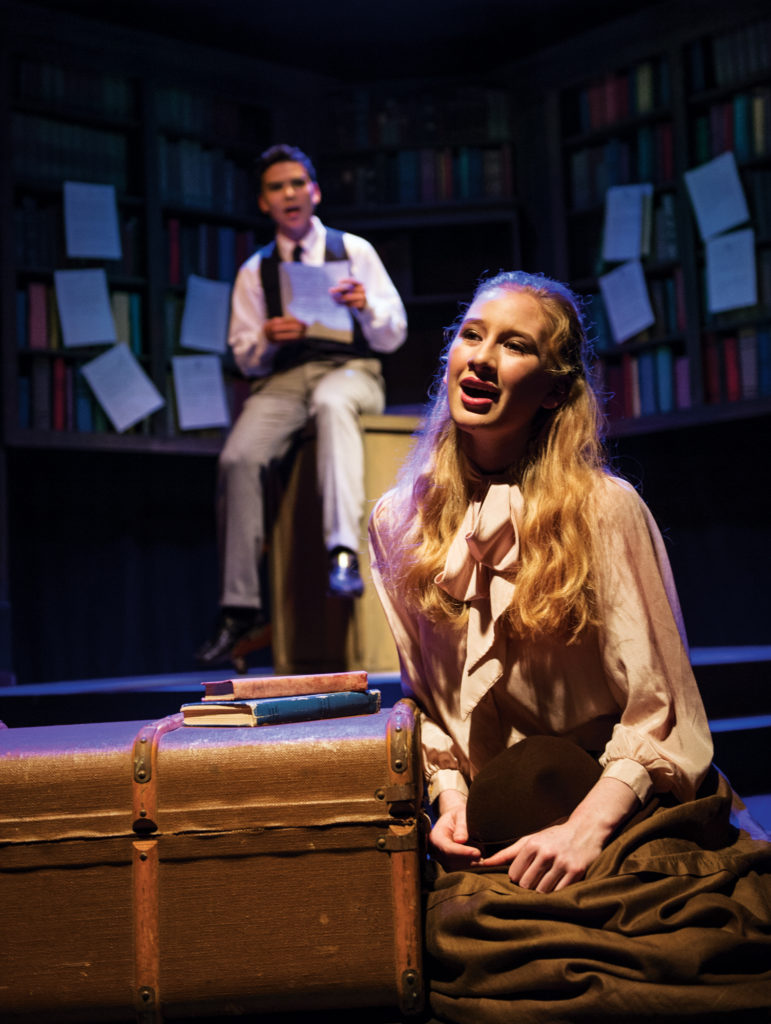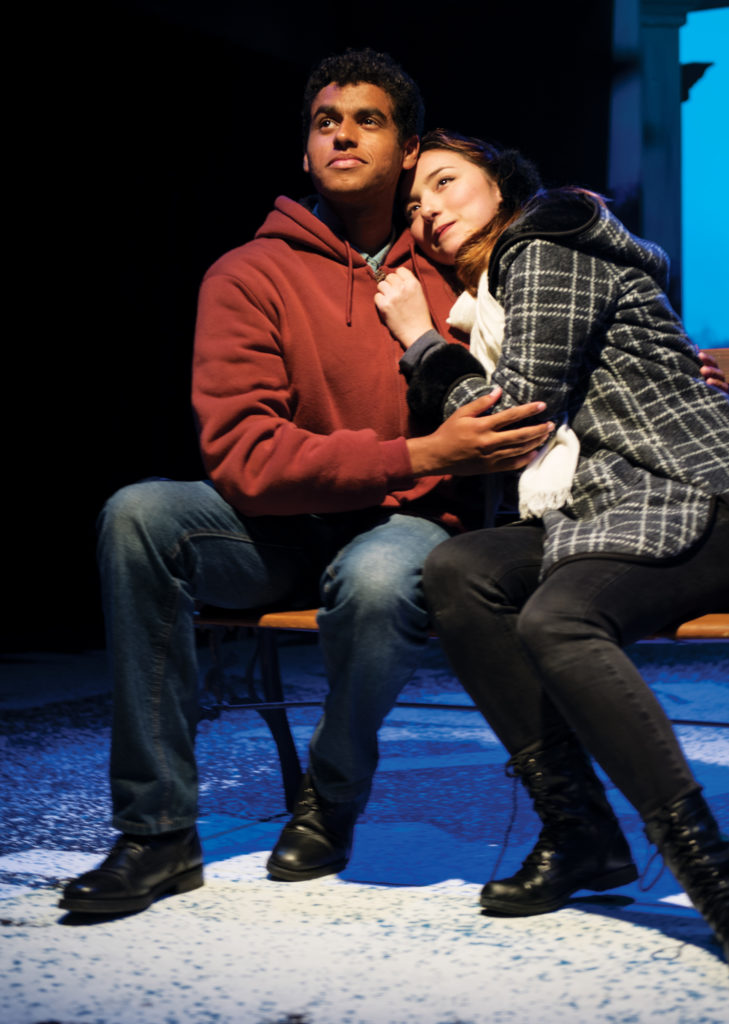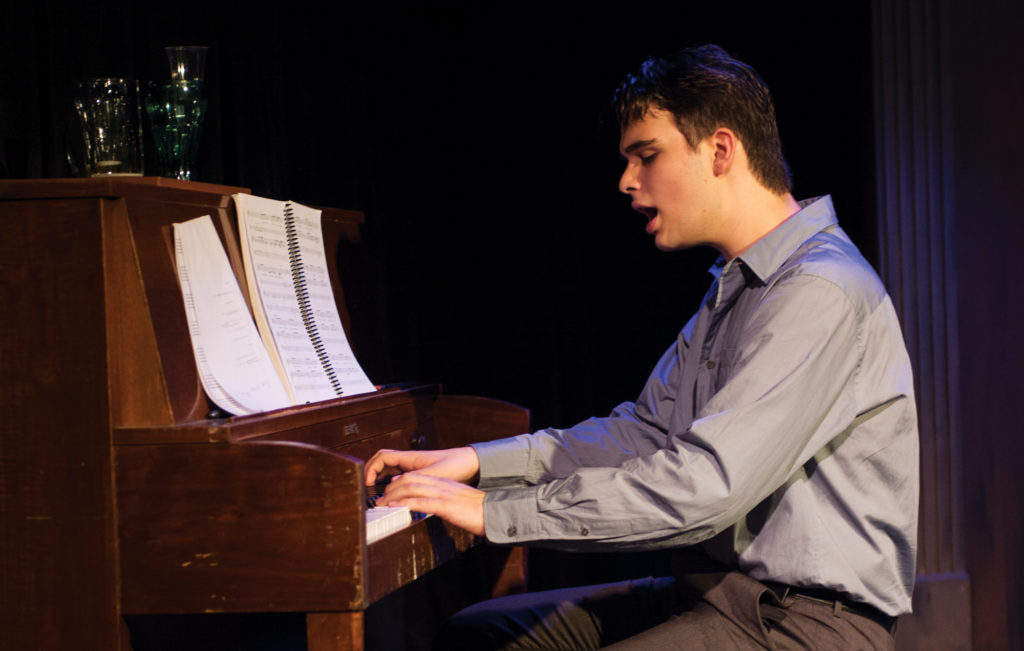By Carlyn Tani ’69
On a bright May afternoon, Punahou’s Drama Workshop, nestled in the basement of Dillingham Hall, was teeming with preparations for an upcoming production of Lanford Wilson’s “Hot l Baltimore.” Backstage assistants hauled in a black velvet curtain to be hung while a dozen students from Theatre Performance class fanned out across the 70-seat house, trading updates about AP exams and Senior Sing. On the 26-by-30-foot stage, a crewmember pushed a threadbare sofa and some rickety props into place, conjuring up the seedy hotel lobby where the play takes place.
Theatre director Paul Palmore sat in front of the stage, script in hand. Once the cast had assembled, he called out, “Christian, get out there on the set. Act II, from the beginning.” The actors took their places and began the run-through. Palmore watched the performers intently, mouthing the lines as he glanced at the script, a half-smile flickering across his face. “No dramatic pauses here, dude,” he said to one lagging actor. “When you come in, be as big as you can,” he told another, gesturing broadly with his arms. At one point, he jumped onstage to choreograph the interplay between two feuding characters. This was Palmore’s final performance before retiring, and he was reveling in the chance to direct one of his favorite plays in the space that embodies the transformative power of theatre.

An Acting Classroom
When Palmore first arrived at Punahou School in 2000, with a Master of Fine Arts in scenic design from the University of Hawai‘i – Manoa and a Master of Arts in acting from University of Michigan, the program consisted of Drama I and Drama II. He immediately revamped the curriculum, adding a class in Theatre Performance to take advantage of the Drama Workshop (DWS), which had been used primarily as the greenroom for main-stage productions. “Our first show in DWS was ‘Home Free!’ a one-act play by Lanford Wilson,” Palmore recalled. That performance drew an audience of two: Academy English teacher Ed Moore and his wife, Delia. The students were disheartened by the lack of turnout but their next performance attracted 15, and audiences grew from then on. Theatre classes and independent study projects currently showcase up to six shows a year at DWS, before packed houses.
DWS has built a reputation for presenting works that are mature and edgy. “It’s our place to do dramas and smaller musicals,” Palmore said, explaining that Dillingham Hall, which seats 640, is difficult to fill with anything other than blockbuster musicals. Recent DWS performances have included “Equus,” a searing psychological drama, and “The Shadowbox,” which explores end-of-life conflicts. The theatre’s intimate size helps actors take on more difficult roles. Last year, Chloe Saracco ’17 acted in “My Sister Lives on the Mantelpiece,” a collaborative project put on by multiple students, which confronts volatile issues such as racism and domestic violence. “It really worked as a show because it was in DWS,” Saracco said. “Because the audience is right there, you feel them come along with you so that you can get to that emotional place much easier.” The audience was so close that during the most dramatic scene, Saracco could hear her mother sniffling in the crowd.

DWS also serves as an acting classroom during the day, and Erica Ito ’17 credited courses such as Character Portrayal and Theatre Performance with drawing out a full range of emotions. “If you ask kids about main stage versus DWS, they would say they learned a lot more in DWS, because the time we spend working on the material there is all about learning the craft.”
Academy students can select from seven curricular choices (taught by two faculty members) that range from Acting Fundamentals and Technical Theatre to Independent Study. Since 2012, theatre course enrollment has grown from around 100 students per year to more than 130 students while Independent Study projects have skyrocketed. Palmore credited the Junior School’s robust theatre program with boosting Academy enrollment and the students’ talent and drive with fueling independent productions. Five years ago, he oversaw one Independent Study every other year but currently advises two or three annually. He’s both surprised and pleased by the trend. “The whole idea is that we’re trying to enable students to do things on their own, and our job is to make that happen,” Palmore said. “The shows we do here in DWS are classic examples of how we’re really a kind of makery.”
An Appetite for More
In 2016, Ito and Candice Hatakeyama ’17 co-wrote the script and lyrics for a comedic farce, “Waiting for Change.” Looking back on the experience, Ito acknowledged that, as novices, the two were in way over their heads. She described a DWS workshop with legendary Broadway composer/lyricist Stephen Schwartz, who wrote “Wicked” and “Godspell,” during which the students presented their work for critique. His reaction? “He hated it,” Ito said. But, she added, the experience taught her to listen to feedback and to persevere amid unexpected setbacks. It also made her more comfortable directing her peers, a skill that would prove essential the next time around.
Last fall, Ito and Nicholas Amador ’18 decided to collaborate on an independent project and present “Merrily We Roll Along,” a Stephen Sondheim musical from 1981, that was critically lambasted and closed on Broadway after only 16 performances. The students wanted to produce the show because they loved its inventive dramatic structure and music. “Some of Sondheim’s best songs are in that show,” Ito said, citing popular numbers such as “Opening Doors” and “Our Time.” She served as producer, assistant director and costume designer while Amador took on the roles of director and musical director.
“I’ve always been told how much work goes into putting on a musical but this really put things into perspective for me,” Amador said. “You’re responsible for the blocking, the props, the costumes, the music, the lights, the performances.” Musical theatre, he added, is among the most collaborative art forms, so he and Ito had to calibrate their approach with the actors. “Working with your friends is very difficult,” Ito explained. “But because of my experience last year, I knew how to be respectful with the right amount of demanding. In the end, it was an unbelievable learning experience to lead a group of my peers.”

Both students acknowledged the critical support they received from the Theatre Department – from advisor Palmore to the costume shop and music teachers. “Merrily We Roll Along” played to full houses and received rapturous standing ovations. It also whetted the students’ appetite for more. Amador said he’s eager to direct again and to write his own material. Ito, who’s headed to University of Michigan to pursue a degree in musical theatre, said she now knows that, “If you have an idea and are committed enough to make it work, you can make it work, with the help of a supportive school community.”
An education in the arts, research shows (see sidebar), gives young people essential skills that can help them surmount the increasing complexities of the modern world. The arts nurture critical thinking, creativity and collaboration, while theatre, in particular, cultivates empathy. For Palmore, the value of presenting a play like “The Hot l Baltimore,” lies in its ability to broaden students’ perspectives. “These are unwanted people and here’s a play about them,” he said of the grifters and hookers who find refuge in the rundown hotel, “and because of that, we become more empathetic. It’s terribly important that our kids understand that there are all kinds of people out there. And theatre teaches that in a very special way. Sure, I want to teach them skills but I also want to teach them a little bit more about humanity.”
Theatre imparts practical lessons as well. “When Nick’s in a show, he does better academically,” Lisa Amador observed of her son. “When he’s memorizing scripts or in rehearsals, he knows he has to be more organized about his time. It’s really a lesson in organization and maturity.” She also appreciated how the School has nurtured her son’s innate talents. “We couldn’t have believed that Nick would be able to sing and dance on stage. But the School recognized it somehow and supported him on this journey. It’s just incredible to me.” Amador, who recently placed second in the National Poetry Out Loud Competition, hopes to major in astrophysics and minor in theatre.
Learning the Most
Back at DWS, after the actors had left and the stage lights were dimmed, Palmore sat reviewing his notes from rehearsal. Reflecting on the 95 shows he’s directed, he recounted how he first fell under the spell of theatre. “When I was in high school, I got turned on to acting by watching my best friend in a show. I did not recognize him until he came out for bows,” he said. “And that’s what I want to teach – the idea of a person becoming somebody else. And because you become somebody else, you learn a little bit more about their background, you learn about their lives.”
Palmore’s dedication to the arts, and his talent for teaching, are woven into the exceptional works he’s showcased at DWS and on Dillingham’s main stage. He credits his success to the ongoing support of his wife, Helen, and his family.
Punahou’s performances – both large and small – rival those of the best performing-arts schools. Main-stage productions allow Palmore to work with co-curricular students from across grade levels on large-scale, ensemble pieces that feature dazzling scenery, music and costumes (the School recently presented a spectacular production of “Les Misérables”). Yet DWS has its own special appeal. “I love the intimacy of this space,” Palmore said, gesturing to the now-empty stage. “Here it’s all about the acting. This is where students learn the most.”
Carlyn Tani ’69 is a Honolulu-based freelance writer and parent of Bobby Foley ’06.
The Drama Workshop is supported by the Darrell, Cathy and Nicki ’18 Lee Endowed Fund for Performing Arts.
An Arts Education
In 2015, a report from the National Endowment for the Arts noted that “… at virtually every stage of life, the arts can foster openness to novelty, encourage connections to people, places, things and concepts, and promote the ability to take multiple perspectives, among other positive outcomes.” A growing body of research supports that notion.
University of California, Los Angeles professor James Catterall published the results of a 12-year study in 2009, that tracked 12,000 secondary students who had taken music or theatre classes into adulthood to find out what, if any, effect arts participation had on their lives. The results showed a positive correlation between a student’s involvement in the arts and his or her future academic and social success. Among other things, the study found that “sustained student involvement in theatre arts (acting in plays and musicals, participating in drama clubs and taking acting lessons) associates with a variety of develop- ments for youth.” According to Catterall, these developments included “gains in reading proficiency, gains in self-concept and motivation, and higher levels of empathy for others.”




